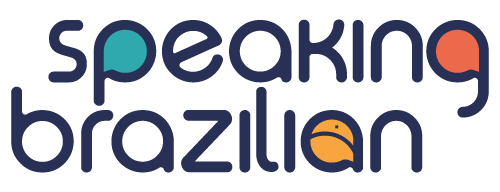Transcription of the Video
*Read original version in Portuguese at the end.
Hi everyone, Virginia here.
Today we’ll have a Q & A session. I selected three questions my students asked me to answer in this video. Let’s go?
Before we begin…
I would like to remind you that I offer a free mini-course in pronunciation. To sign up, visit my website: school.speakingbrazilian.com.
If you like my videos, don’t forget to subscribe to my channel to receive notifications whenever I post a new video.
Let’s move on to the first question:
This question is from a student of the Speaking Brazilian Academy, Jessica Tedone. She asked:
1. I don’t know how to practice every day. What do you suggest?
Well, the ideal, obviously, would be to practice with native speakers. But it’s very difficult to have the opportunity to practice Portuguese with Brazilians every day.
However, talking with native speakers is not the only way to practice Portuguese.
I recommend that you create the habit of studying Portuguese for 30 minutes every day.
Add this to your morning or evening routine, whichever works best for you, but you must make a commitment to yourself to dedicate 30 minutes of your day, each day, to improve your Portuguese.
I recommend the following routine:
First step: Study vocabulary and grammar with the Anki app for 10 minutes.
Study the deck and add at least one new word or phrase per day.
Second step: Listen to a podcast in Portuguese for 10 minutes. I recommend two podcasts:
Speaking Brazilian Podcast andCafé Brazil Podcast
Third step: Do an imitation exercise for 10 minutes. Listen to an audio and repeat it aloud mimicking the pronunciation of the native speaker.
If you do these three exercises for only 30 minutes every day, I guarantee that your Portuguese will improve a lot each day.
The next question is from Mercedes Vargas, a student who is part of the Speaking Brazilian community on Facebook. She asked the following question:
2. What does the letter “o” mean and when is it used?
Several other students have asked me the same question. The word “o” means “the”. It is a definite article that is used to talk about specific things. For example:
O bolo de chocolate está na mesa. (The chocolate cake is on the table.)
Here, we are talking about a specific cake, the chocolate cake.
Here’s another example:
Tem um bolo na mesa. (There’s a cake on the table.)
Here, we are talking about any cake, not specific.
Articles in Portuguese vary in gender and number. For example:
O bolo [The cake (masculine)]
A torta [The pie (feminine)]
Os bolos [The cakes (masculine plural)]
As tortas [The pies (feminine plural)]
The third question was sent by a follower of Speaking Brazilian on Instagram. The question is:
3. What does “da boca pra fora” mean?
The expression “from the mouth out” is used to indicate that you said something that didn’t mean or something that you don’t believe in.
For example:
Ela disso isso da boca para fora. (She didn’t mean what she said.)
It means that she doesn’t “mean it”, what she said didn’t come from her heart, but only from her mouth.
That’s it! These were the three questions I selected for today’s lesson. If you want me to answer your question in the next video, leave your question in the comments below.
That’s it for today, everyone. Remember to give this video a thumbs up and subscribe to my channel! Every week, I post a new video with tips on grammar, expressions and pronunciation of Brazilian Portuguese.
See you next time! Bye-bye!
Q&A com Virginia #2
Oi pessoal, aqui é a Virginia.
Hoje nós vamos ter uma sessão de perguntas e respostas. Eu selecionei três perguntas que eu recebi dos meus alunos para responder neste vídeo. Vamos lá?
Antes de começar…
Eu gostaria de lembrá-los que eu ofereço um minicurso de pronúncia gratuito. Para se inscrever, visite o meu site: school.speakingbrazilian.com.
Se você gosta dos meus vídeos, não esqueça de se inscrever em meu canal para receber notificações sempre que eu publicar um novo vídeo.
Vamos então para a primeira pergunta. Esta pergunta é de uma aluna da Academia Speaking Brazilian, Jessica Tedone. Ela perguntou:
1. Eu não sei como praticar todos os dias. O que você sugere?
Bom, o ideal, obviamente, seria praticar com falantes nativos. Mas é muito difícil ter a oportunidade de praticar português com brasileiros todos os dias.
No entanto, falar com falantes nativos não é a única maneira de praticar o português.
Eu recomendo que você crie o hábito de estudar Português por 30 minutos todos os dias.
Adicione isto à sua rotina matinal ou noturna, o que for melhor para você, mas você precisa ter um compromisso consigo mesmo de dedicar 30 minutos do seu dia, todos os dias, para melhorar o seu português.
Eu recomendo a seguinte rotina:
Primeiro passo: Estude vocabulário e gramática com o aplicativo Anki por 10 minutos.
Estude o baralho e adicione pelo menos uma nova palavra ou frase por dia.
Segundo passo: Ouça um podcast em Português por 10 minutos. Eu recomendo dois podcasts:
Speaking Brazilian Podcast e Café Brasil Podcast
Terceiro passo: Faça um exercício de imitação por 10 minutos. Ouça um áudio e repita em voz alta imitando a pronúncia do falante nativo.
Se você fizer estes três exercícios por apenas 30 minutos todos os dias, eu garanto que o seu português vai melhorar muito a cada dia.
A próxima pergunta é da Mercedes Vargas, uma aluna que faz parte da comunidade Speaking Brazilian no Facebook. Ela perguntou o seguinte:
2. O que significa a letra “o” e quando é usada?
Vários outros alunos já me fizeram esta mesma pergunta. A palavrinha “o” significa “the”. É um artigo definido que é usado para falar sobre coisas específicas. Por exemplo:
O bolo de chocolate está na mesa.
Aqui, estamos falando de um bolo específico, o bolo de chocolate.
Veja outro exemplo:
Tem um bolo na mesa.
Aqui, estamos falando de qualquer bolo, não específico.
Os artigos em português variam em gênero e número. Por exemplo:
O bolo (masculino)
A torta (feminino)
Os bolos (masculino plural)
As tortas (feminino plural)
A terceira pergunta foi enviada por um seguidor do Speaking Brazilian no Instagram. A pergunta é a seguinte:
3. O que significa “da boca pra fora”?
A expressão “da boca pra fora” é usada para indicar que você disse algo que não quis diz dizer ou algo que você no fundo não acredita. Por exemplo:
Ela disso isso da boca para fora.
Quer dizer que ela não “mean it”, o que ela disse não veio do coração dela e sim apenas da boca pra fora.
É isso! Estas foram as três perguntas que eu selecionei para a lição de hoje. Se você quer que eu responda a sua pergunta no próximo vídeo, deixe a sua pergunta nos comentários abaixo.
É isso por hoje, pessoal.Lembre se dar um likeneste vídeo e de se se inscrever em meu canal! Todas as semanas, eu posto um novo vídeo com dicas de gramática, expressões e pronúncia do português brasileiro.
Até a próxima! Tchau, tchau!


